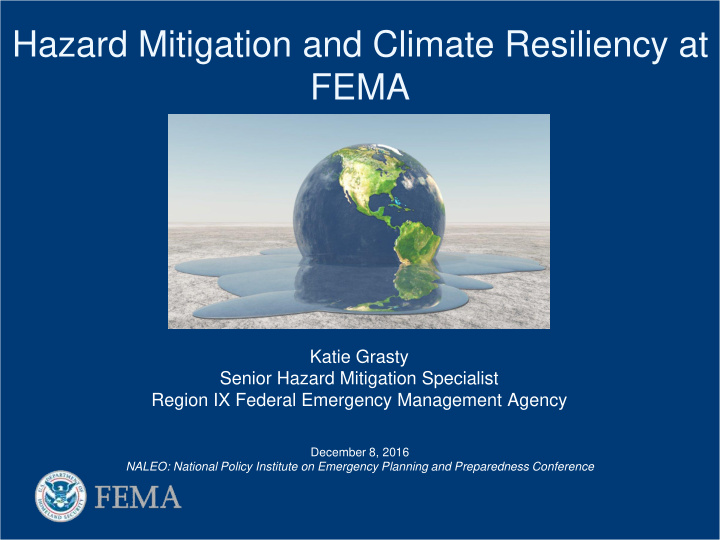



Hazard Mitigation and Climate Resiliency at FEMA Katie Grasty Senior Hazard Mitigation Specialist Region IX Federal Emergency Management Agency December 8, 2016 NALEO: National Policy Institute on Emergency Planning and Preparedness Conference January 2009
Overview Mitigation Funding Programs Mitigation Projects Other Considerations Examples (HI Sea Level Rise and CA Wildfires) Future of Climate Change Adaptation and Resiliency New Resiliency Project Types Challenges and Lessons Learned How to Sign up for Grants Information 2 January 2009
Mitigation Funding Programs 3 January 2009
Mitigation Actions Prevention Property Protection Public Education and Awareness Natural Resource Protection Structural Projects 4 January 2009
Seismic Retrofit 5 January 2009
Wildfire Mitigation Removing fuel sources Hazardous fuels reduction Defensible space Ignition resistant materials 6 January 2009
Acquisition/Elevation 7 January 2009
Flood Drainage Prevention Property Protection Public Education and Awareness Natural Resource Protection Structural Projects 8 January 2009
Innovative Mitigation Actions 1. Hazardous Fuels Reduction - prevents wildfires 2. Logjam - deflects river flow to prevent erosion 3. Jute Netting - helps control erosion and reduces risk of landslides 9 January 2009
Other Considerations General Eligibility Criteria include: Consistent with State and Local Hazard Mitigation Plans Have a beneficial impact on declared area Offer an independent solution to a problem Are cost-effective (benefit/cost ratio of 1.0 or higher) Are consistent with Environmental/Historic Preservation laws and executive orders - Emergency Provisions Can be packaged with other programs but cannot duplicate other funding sources 10 January 2009
Mitigation Actions 11 January 2009
California Wildfires Drought + Fire + Rains = mudflows, debris flows, floods Solutions: Hydroseeding, erosion control measures, culvert enlargement, stream restoration 12 January 2009
New Resiliency Project Types: Flood diversion and storage: • Diversion and storage of floodwaters into reservoirs, floodplains, wetlands, and green infrastructure. Green infrastructure: • R eplicates a site’s predevelopment, natural hydrologic function infiltrating into ground. Aquifer storage and recovery: Capturing water when abundant and recovering when needed; injection well or infiltration. Floodplain and stream restoration: Remove structures, restore native vegetation, ensure connectivity and storage capacity. 13 January 2009
Challenges and Lessons Learned Challenges: • Acceptance of a changing environment • Desire to maintain status quo because “this is how we have always done things” • Incorporation of technology Lessons Learned • When in doubt, hit the road • Evaluate and improve • Network! • Finding common ground 14 January 2009
For Grants Information: Visit - https://service.govdelivery.com/accounts/USDHSFEMA/subscriber/edit 1. Enter/Confirm email 2. Select email delivery preference and submit 3. Click add subscriptions 4. Under Mitigation-Mitigation Grants, select all categories under Mitigation Grants Select all pages in Mitigation Grants 1. Flood Mitigation Assistance Program 2. Hazard Mitigation Grant Program 3. Pre-Disaster Mitigation 4. Flood Claim 5. Severe Repetitive Loss 15 January 2009
Questions? Katie.grasty@fema.dhs.gov January 2009
Recommend
More recommend